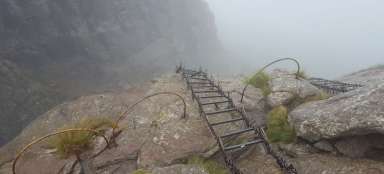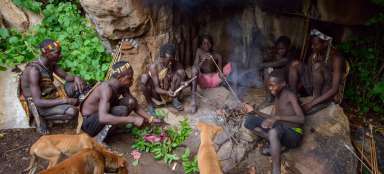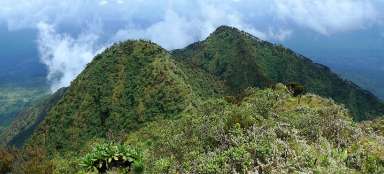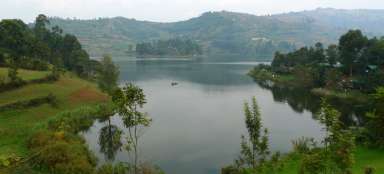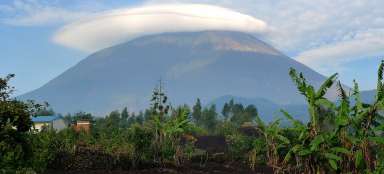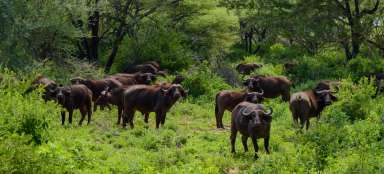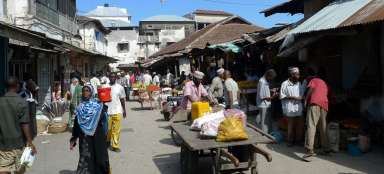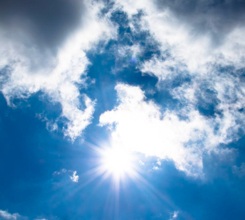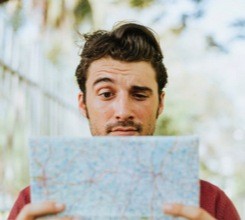Rafting under Victoria Falls

Rafting on the Zambezi River below Victoria Falls is said to be the most difficult commercial rafting in the world.
Passing through rapids is really challenging
When I heard about rafting on the Zambezi River below Victoria Falls, I was a little skeptical about another tourist trap. The Zambezi is a very calm, wide-flowing river above the waterfalls, on which cruise ships pass lazily and tourists are served overpriced dinners. In addition, in November there is a dry season and the water level is lower. But then I learned that it is said to be the most difficult commercial rafting in the world and my interest increased. However, I was only convinced by the stories of the participants, who described huge rapids and counted how many times they overturned and bathed. So I thought this experience might be worth the non-Christian $ 130. However, the next morning I checked that it was a good choice. Transportation, training and equipment were up to standard and my confidence in this organization was growing. Even the usual signature on the topic „I'm aware that I have to, I must not, I can drown“, etc. was electronically registered on the iPad. We choose solid-looking equipment and get on a truck that takes us to the famous Victoria Falls Bridge. Here we have to descend deep to the bottom of the canyon along a rather steep rocky path and metal ladders. I'm excited to start sight from the waterfalls almost directly under the only bridge between Zimbabwe and Zambia. Before we go on the water, we complete paddling training at various commands of the helmsman and then we immediately go for it. We learn that a total of 19 large rapids await us on a section of about 26 km. The rapids are of difficulty WW III + to WW V and some have quite apt names such as „Washing machine“, „Stairs to hell“, „Devil's toilet bowl“ and the like. Numerous rapids classified under WW III + do not count into the total 19, they only drive us quickly to more and more wilderness. We ride two rafts, each with 5 clients, a helmsman and his assistant. We are surrounded by three kayaks, whose task is to catch those rafters who, after falling out of the boat, fail to swim back to the raft, and in addition, they also film and photograph. After passing the first rapids of the WW IV + level of difficulty, I look at the thunderous elderly English farmer who is paddling next to me, who is on a raft for the first time and I can see in his eyes that he is beginning to understand well what difficult rafting means. On the next rapids, a giant wave throws him across the raft at me, so I just can't get out of the boat with luck. However, we are gradually improving and gaining self-confidence. We eagerly obey the helmsman's orders, even though sometimes we can hardly hear them because of the roar of the water and the waves roll over our heads. Mainly hold the paddle and stay in the boat! We use the silence between the individual rapids to enjoy amazing views of the Zambezi Canyon. Vertical basalt walls about 100 m high arch over our heads and are only about 100 m apart and most of it is occupied by a wildly flowing river. An experienced guide shows us sailing eagles and other birds. Then, unfortunately, he showed us the crocodiles resting on the banks. It is true that they are much smaller than the giants above the waterfalls for many years, but his reassurance that the paddlers did not attack was not entirely convincing. So there is no shortage of adrenaline even between the rapids. In any case, after detecting the presence of crocodiles, the deployment of the entire crew in paddling and following the helmsman's orders was even more diligent. It is the beginning of November, so the flow is lower (it has „only“ about 1500 m3 / sec) and huge boulders are sometimes visible along the river. During the rainy season, the flow is said to increase up to 10 times and the river will rise by more than 12 m and everything will then find itself under water. Reportedly, the waves and cylinders of the rapids are milder, but the huge current makes any floating impossible.
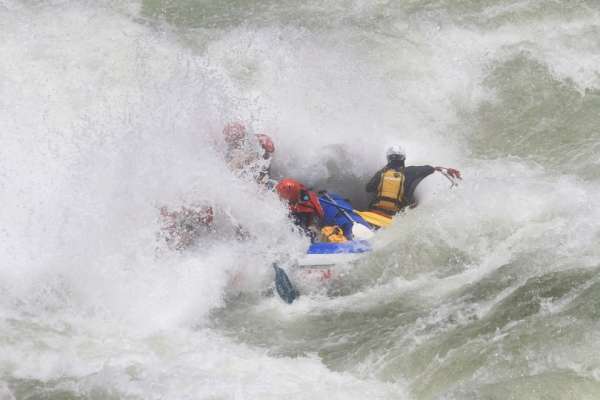
Overturning a raft is really easy on this wild river
One of the rapids is classified as the highest level of difficulty of WW VI. It's called „Commercial Suicide“ and fortunately for us, it's banned for our voyage. So it is necessary to carefully pull the raft on the rope. We get out and go to see the „rapids“ on the rocks. Basically, it's such a gradual waterfall. When stumbling over rocks, we admire geomorphological formations – giant pots. We know them from our river Vydra, but the dimensions and frequency of the local pots are truly unprecedented. Once we have climbed the rock barrier, we find that we can get back to the raft only by jumping from a rock of about three meters into the river and swimming into the silence, where the raft is already parked. The water is pleasantly warm, but it's still another adrenaline experience. We are approaching the end of the voyage. Surprisingly, we have not yet overturned and the water has only swept away our Welsh co-driver. However, the guide laughs at our growing self-confidence and informs us that the penultimate rapids are called Oblivion (Unkind) but it is called the „Public Swimming Pool“. He obviously knew what he was talking about, at first we pierced a giant water cylinder, but then a huge wave overturned the entire raft. I fly into the water, a raft on me and a big Englishman and others behind him. The seconds deep in the swirling water, where it's hard to tell where it's up and where it's down, were long enough. It's not worth trying to swim underwater in these conditions, so I'm just waiting for the vest to finally pull me to the surface and hold the paddle. Fast to the raft and grab the ropes on it. The guide and the assistant climb nimbly onto the inverted raft and expertly turn it over. We climb hard up and then we reach the fast approaching last rapids. However, the most difficult part of the event is still waiting for us. We have to climb the steep rocky steps of those about 100m in the midday heat. Fortunately, the equipment is carried by the organizers, who also blow out the rafts and drag them up. Rafting on the Zambezi really spiced up our stay in a rather commercialized area near the waterfalls. With the right courage or experience, it's really worth it. Given that it is likely that a person will drink a lot of water from an African river, I highly recommend a suitable vaccination and also have suitable tablets on hand for possible digestive problems.




